#this fabric feels different than the satin marie rose I have
Explore tagged Tumblr posts
Text

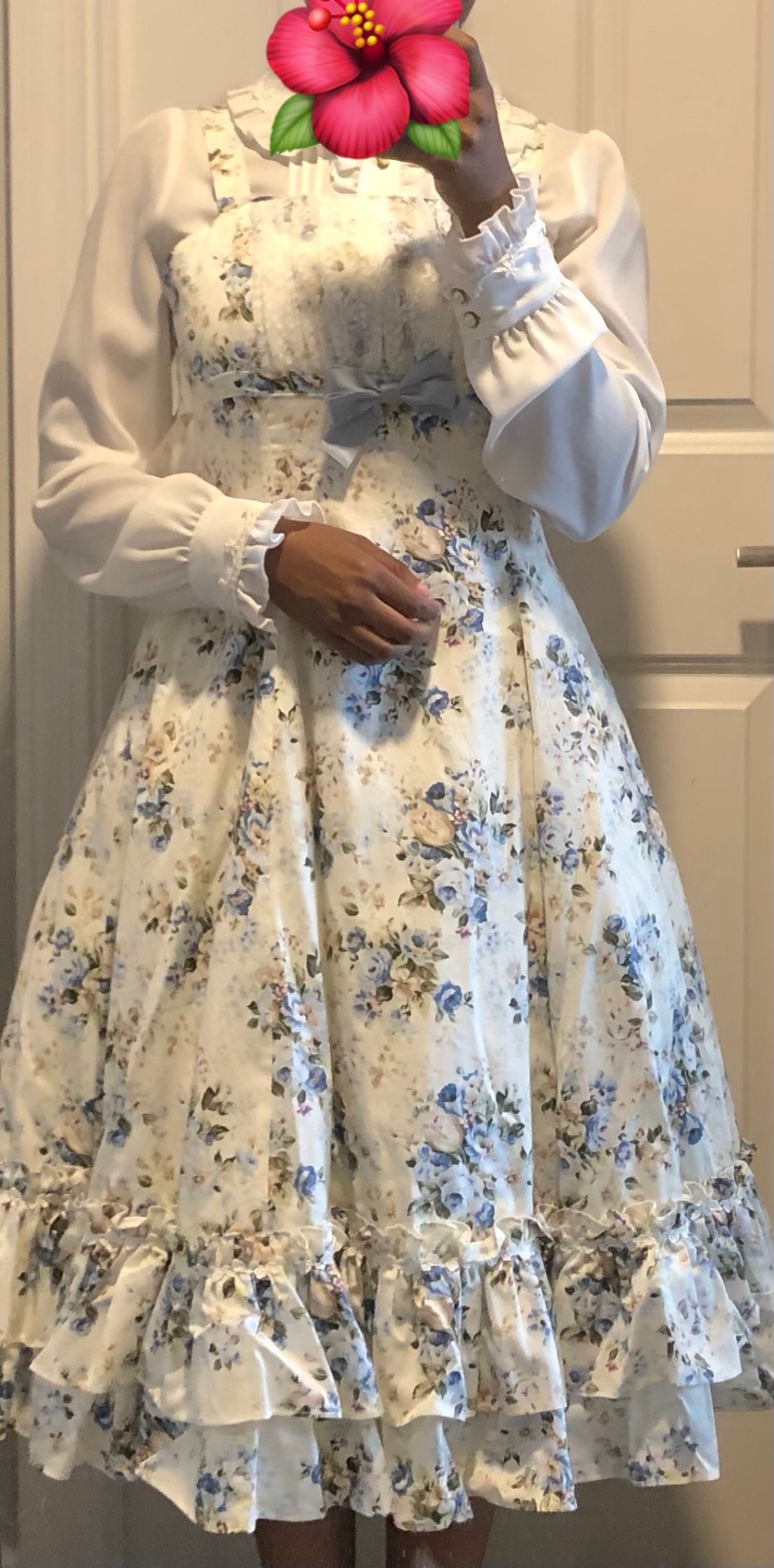
VM’s new Rococo bouquet came in the mail. Blouse is Amavel. Did anyone else get theirs?
#lolita fashion#classic lolita#victorian maiden#lilac coords#this fabric feels different than the satin marie rose I have#it reminds me of the Meta special set I have#vm
20 notes
·
View notes
Text
Women’s Fashion Over Time
In its vast timeline, the history of fashion in art reveals a complex socio-economic system influenced by a culture of valuing individual collectives in a world of dynamic change. It is a unique system in that which its influences are found in close quarters; a grapevine of cultural impact showing people influencing people. The ensembles worn by subjects in various paintings and sculptures present us with a glimpse into the socio-economic conditions under which fashion became a commodification of social status and a symbol of societal and cultural value. As cultural events and new political climates rise, causing shifts in values and general rules of fashionable appearance tastes in fashion appears to change. Yet the relatively stable constant in notions towards fashion is a prescribed label of class, and therefore, your worth and position in society, associated with the clothing you wore. In a series of six costumes inspired by the Early Renaissance, the High Renaissance, the High Renaissance in Europe, Baroque art, Rococo to Neoclassicism, and Romanticism, I will break down the fashion trends of each period, focusing on iconic features of each fashion period and briefly explaining the cultural context of each garment.
The Early Renaissance
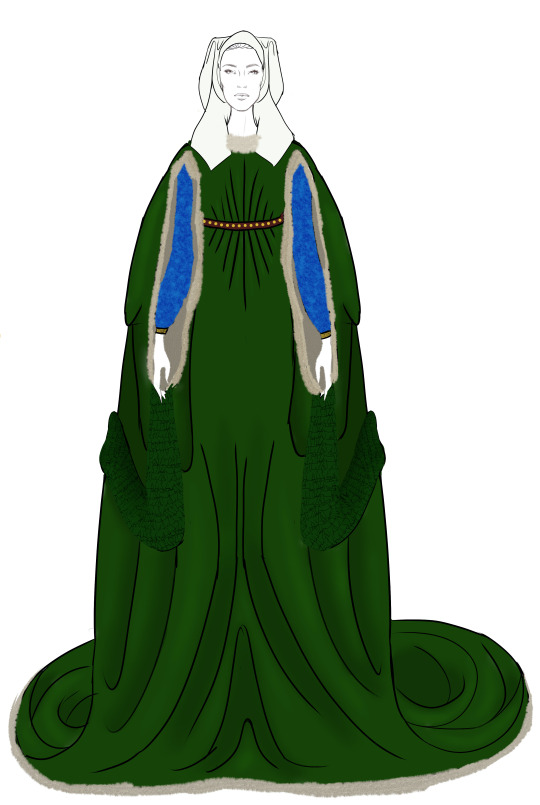

This costume is based on the ensemble worn by Giovanni Arnolfini’s wife in the painting Giovanni Arnolfini and His Wife by early Renaissance painter Jan Van Eyck. A popular staple piece in early Renaissance fashion was the houppelande which was carried over from the fashion of the middle ages. In The Concise History of Costume and Fashion by James Laver, he describes the general appearance of the houppelande as a garment that fitted the shoulders and was loose below, with a belt at the waist; the houppelande is what will later be known as ‘gown’.[2] This replication of a typical houppelande has a high collar and extremely long sleeves, fur trimming and fur lining, and hanging tippets from the edge of the sleeve to the back of the gown. The gown itself is extremely long, ballooning outward from the waist. The houppelande could be made in a selection of fabrics such as wool, silk, and velvet[3], and were could be dyed a rich, vibrant colour as seen in Jan Van Eyck’s painting. Since the middle ages, the use of fur in fashion had become symbolic of wealth and importance and was oft worn by nobility.[4] Since fur was difficult to come by, it was an elitist luxury used in excess by middle and higher class people, establishing a social distinction between them and the lower-class through their clothing. As for the headdress, at this point, not much has changed since the middle ages in terms of style. However, the custom of covering mature and married women’s hair was becoming less strict, and we see more women revealing their hairstyle beneath their headdress.[5]
The High Renaissance
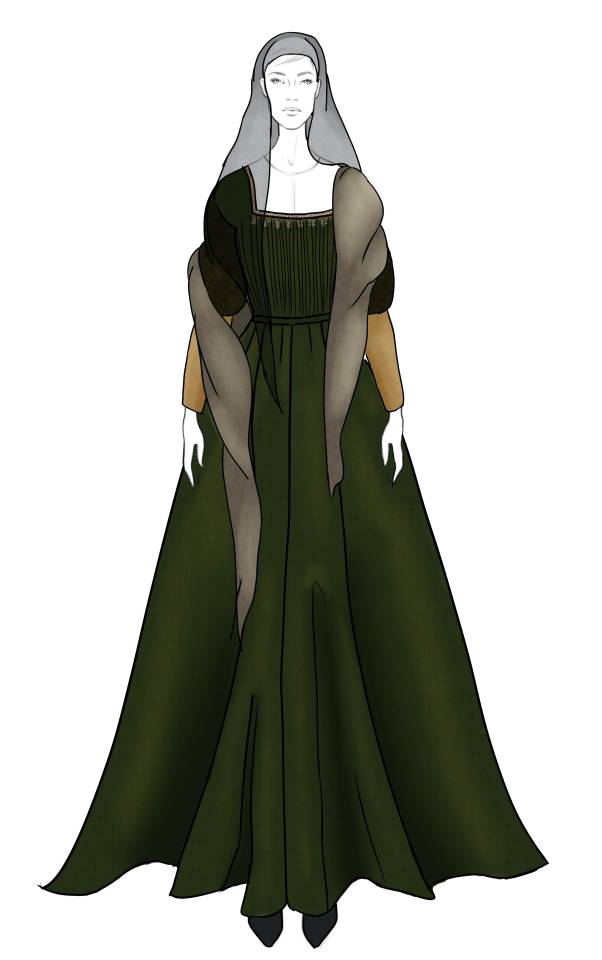

This High renaissance costume is based on the Mona Lisa by Leonardo da Vinci. The During the High renaissance, many cultural trends such as the rise and spread of books, the expansion of trade and exploration, and the increase in power and wealth of national monarchies in France, England, and Spain influenced tastes in fashion and the dynamic changes fashion underwent, as well as the idea of the modern ‘trendsetter’.[6] The essential garment for the High Renaissance woman was the gown. Its general features were the bodice, a skirt, and sleeves. The complex ensemble of the gown during this period can be seen in da Vinci’s Mona Lisa. The gown could be made from luxurious materials such as silk, velvet, and lace, worn with lavish jewelry, and decorated with intricate patterns of stitching and embroidery.[7] While the gown silhouette was common across social classes, the distinction lies within the materials used. Although the wealthy and powerful used expensive textiles for their gowns, the lower-class was still capable of emulating the gown with the materials they had access to such as wool and cotton.
The High Renaissance in Northern Europe
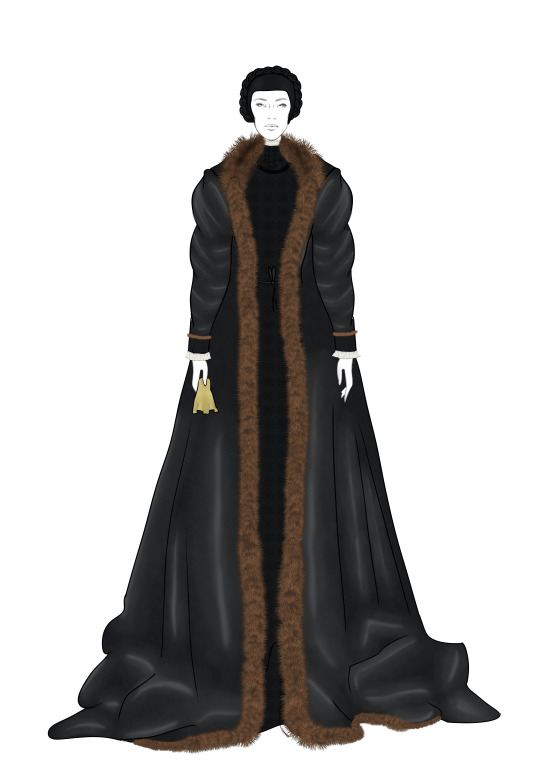

My iteration of Northern European High Renaissance fashion is based on Hans Holbein the Younger’s Portrait of Christina of Denmark. This portrait demonstrates the conservative side of fashion that was flourishing alongside a bold, vibrant movement that was challenging established trends. The model adorns a dark, velvet gown with a high collar; underneath we see a glimpse of the ruffs from her high collared undershirt. The ruffs were a common feature of the late fifteenth and sixteenth centuries, typically characterized as an upright, stiff collar that ruffles around the neck; ruffs were commonly adorned by noblemen and noblewomen.[8] Now, Holbein’s Portrait of Christina of Denmark does not show the typical extravagant ruffled collar, which could have been a stylistic choice by Holbein to allow the fur lining and trim of the subject’s outer gown to stand out, and remain the statement feature representing her wealth in the painting. The large size of the outer gown appears to further imply how much fur the gown is made of.
Baroque Art
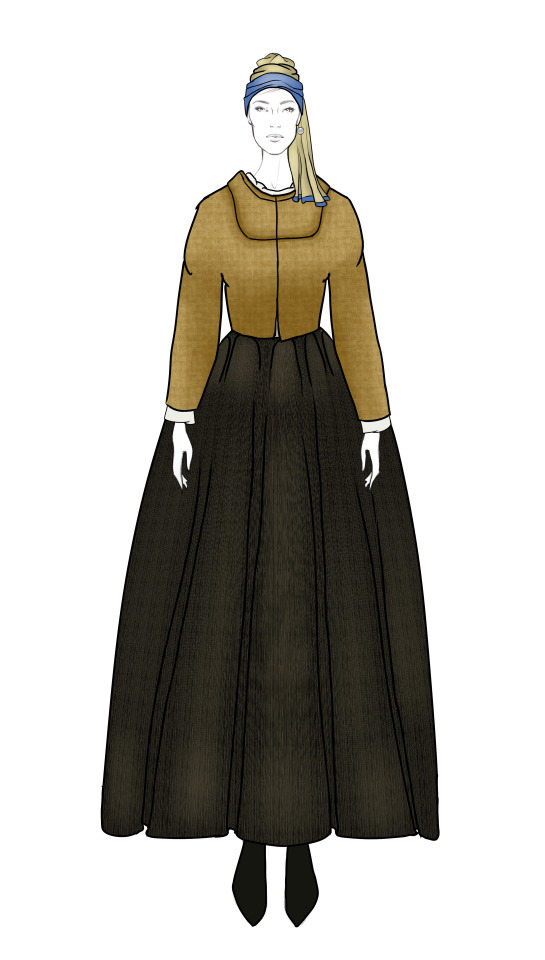

The Baroque artwork I’ve based this costume design on is Vermeer’s, Girl with a Pearl Earring. The Baroque period introduced innovations to the popular sixteenth-century gown. At the time Vermeer’s Girl with a Pearl Earring was composed, seventeenth-century fashion had already gone through several evolutions. Stomachers, which was either a v-shape or u-shape panel meant for decoration and structure, had become stiffer and flatter and elongated past the line of the waist.[9] Replacing the trend of using wired hoops, or farthingales, to give body to the skirt was the petticoat. The petticoat was a practical solution to the everyday issues of functionality women faced with farthingales. Petticoats made of cotton or wool were perfect for warmth, while more fashionable petticoats were made of taffeta, satin, linen, or a combination of starched fabrics.[10]
Rococo and Neoclassicism
This costume was inspired by Vigee Le Brun and her artistic style which can be described as being a mix of rococo colours with elements of the Neoclassic style. As a prolific French portrait painter, one of her prominent subjects for portraits was Marie Antoinette, the Queen of France who despite her tumultuous life in the public eye, was a fashion icon. The genius in Le Brun’s craft lies in her vast knowledge of current fashion and her awareness of the power of appearance.
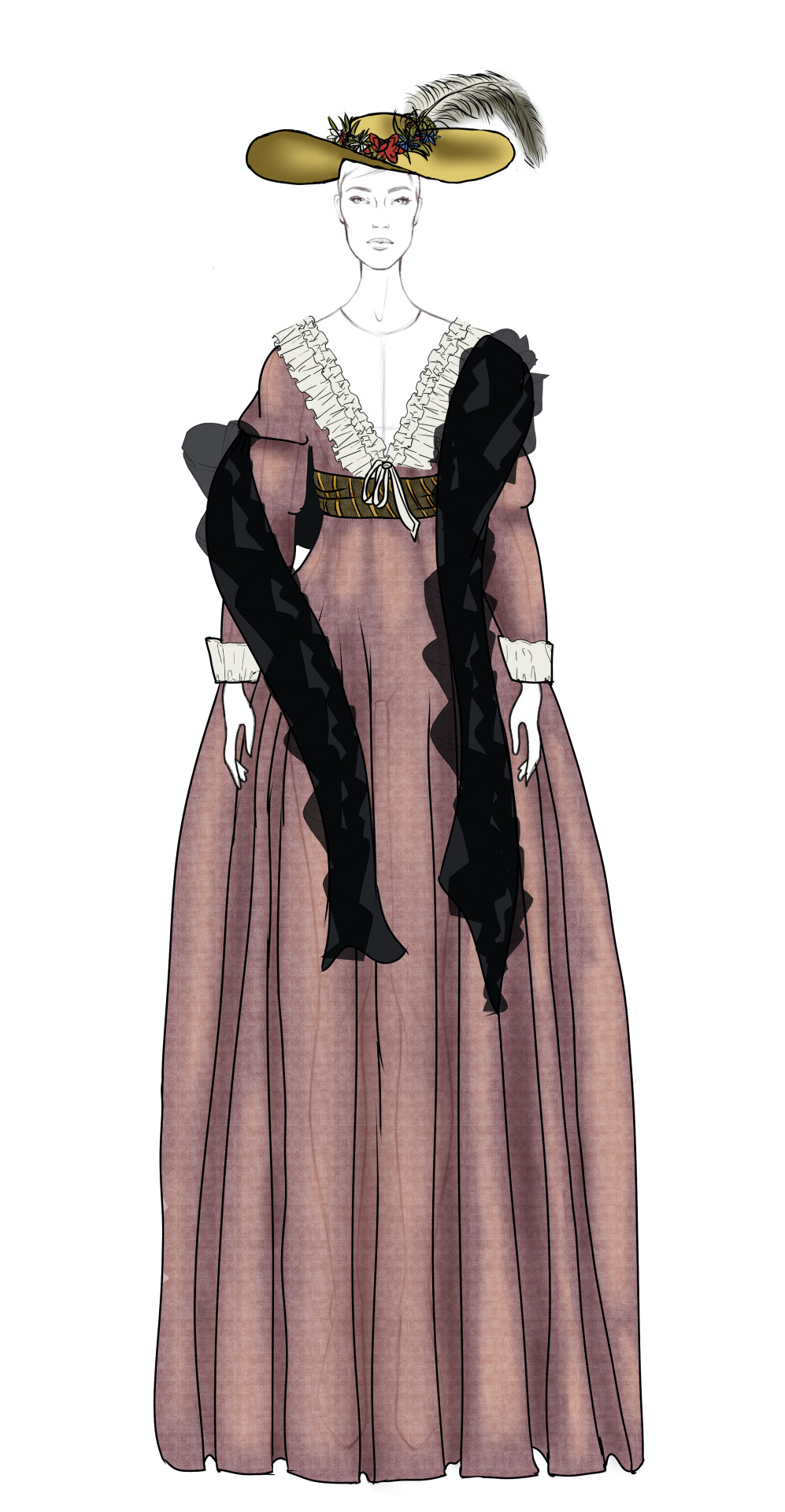

I based this costume on Vigee Le Brun’s, Self Portrait in a Straw Hat. In the painting, Le Brun is wearing a variation of the robe en chemise which emerged during the late eighteenth-century period as tastes in fashion moved away from the early period’s penchant for fuller-bodied skirts.[11] While its design echoes elements of early Rococo style, the robe en chemise was a gown made simple. These dresses were usually made of sheer, white cotton, with high waists and wrapped with a decorative satin sash; its slender silhouette was inspired by the fashion of ancient Greece and ancient Rome.[12] These dresses could also come in various colours, such as the rose-gold coloured dress Le Brun is wearing in her self-portrait. With its sheer material and low-cut neckline, the robe en chemise gained widespread attention because of its revealing nature; until this point, the gowns we’ve seen have been voluminous and covered much of the female body. Yet, this scandalous fashion found its way into the wardrobe of royalty, and most likely, the wardrobe of some upper-class women who wanted to be revered for wearing the latest fashion. This portrait of Marie Antoinette wearing a robe en chemise was painted by Le Brun.
Romanticism
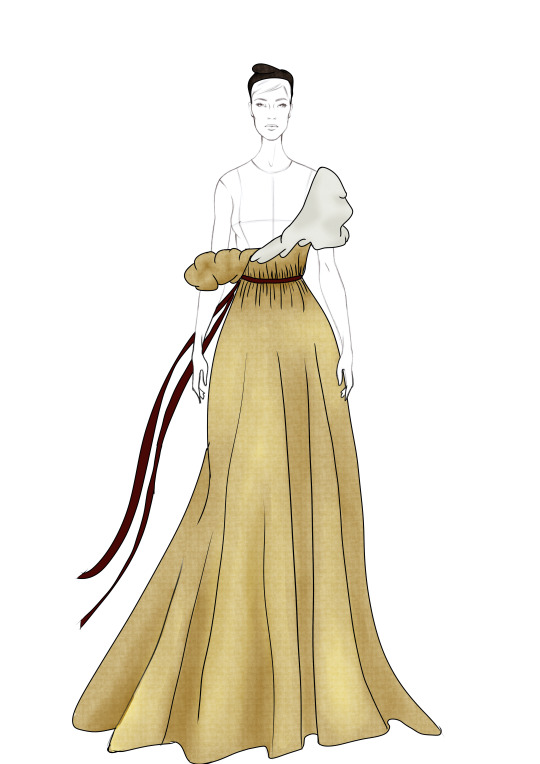

Based on Delacroix’s, Liberty Leading the People, this costume is an iteration of the symbolic fashion of the woman in his painting. She is Liberty; she represents freedom, in an image that evokes a triumphant revolution as she leads people on the battlefield. The Romantic movement differed vastly from the current situation in early nineteenth-century France, which was characterized by social unrest and civil war between the bourgeoisie and the working class.[13] Romanticism was mostly a reaction to the modern realities brought on by the industrial revolution; the romantic movement in art reveals a desire to escape these modern realities, a theme which Delacroix’s painting emulates perfectly.
Liberty Leading the People encapsulates the transitional period between Neoclassicism and Romantic sensibilities.[14] There are neoclassical elements in Liberty’s appearance, but most prominent is her dress. The painting feels reminiscent of the time of unrest during the French Revolution, which Liberty embodies in her wearing a robe en chemise, referred to simply at this point as ‘a dress’. In general, dresses of any kind were lighter and much sheerer than garments from the eighteenth-century but the general features of the dress were kept the same: made from any selection of fabrics and usually white or light in colour, short sleeves, high waists and long, straight skirts.[15]
From this brief overview of women’s fashion over time, it is evident that notions towards dress and appearance, and how we tend to associate certain styles of fashion to specific groups of people and/or cultures have not changed. Although fashion continues to evolve, the same old fashion trends appear and disappear, then reappear; reinvented or inspiring a consequent fashion movement. There is a romantic sensibility in the way we often tend to return to past fashion trends. It begs the question if there will ever be a completely fresh fashion movement, or will our futile attempts remain the shells of historic innovations in fashion from the past. Nevertheless, as one of few primary resources for contemporary fashion designers, these artworks reveal the true impact of fashion and art as they continue to influence fashion and social cultures in our modern world.
––––––––––––
Footnotes
[1] Ibid. 600.
[2] Laver, "The Concise History of Costume and Fashion: Laver, James, 1899-1975: Free Download, Borrow, and Streaming." Internet Archive. January 01, 1969. Accessed July 17, 2020. https://archive.org/details/concisehistoryof00lave/mode/2up, 64.
[3] Pendergast, Sara, Tom Pendergast, and Sarah Hermsen. Fashion, Costume and Culture: Clothing, Headwear, Body Decorations, and Footwear through the Ages. Vol. 3. Detroit: U.X.L, 2004, 450.
[4] Ibid. 624.
[5] Ibid. 488.
[6] Ibid. 469.
[7] Ibid. 477.
[8] Ibid. 482-483.
[9] Ibid. 521; 525.
[10] Ibid. 523.
[11] Ibid. 570.
[12] Ibid. 570
[13] Hurley, Clare. "French Romantic Painter Eugène Delacroix at the Metropolitan Museum in New York." French Romantic Painter Eugène Delacroix at the Metropolitan Museum in New York. December 20, 2018. Accessed July 22, 2020. https://www.wsws.org/en/articles/2018/12/20/dela-d20.html.
[14] Ibid.
[15] Pendergast, Sara, Tom Pendergast, and Sarah Hermsen. Fashion, Costume and Culture: Clothing, Headwear, Body Decorations, and Footwear through the Ages. Vol. 3. Detroit: U.X.L, 2004, 622.
–––––––––––
Bibliography
Hurley, Clare. "French Romantic Painter Eugène Delacroix at the Metropolitan Museum in New York." French Romantic Painter Eugène Delacroix at the Metropolitan Museum in New York. December 20, 2018. Accessed July 22, 2020. https://www.wsws.org/en/articles/2018/12/20/dela-d20.html.
Laver, James. "The Concise History of Costume and Fashion: Laver, James, 1899-1975: Free Download, Borrow, and Streaming." Internet Archive. January 01, 1969. Accessed July 22, 2020. https://archive.org/details/concisehistoryof00lave/mode/2up.
Pendergast, Sara, Tom Pendergast, and Sarah Hermsen. Fashion, Costume and Culture: Clothing, Headwear, Body Decorations, and Footwear through the Ages. Vol. 3. Detroit: U.X.L, 2004.
1 note
·
View note
Text
In addition to posting pictures, I also wanted to talk about how I feel about each main piece.
JSKs/OPs
Row 1: I bought this Frill Ribbon Special Set because it was cheap and I wanted a JSK from Meta. It's not one of my favorite JSKs but I'm having a hard time letting it go. It's my second brand purchase and it's very sentimental to me. I bought Deborah Doll this year and it was well worth the money imo. I love MM and I'm happy I was able to get it at a reasonable price. MM is very rare and expensive & hard to get. This is one of their few pieces that fit without having to do alterations. I'm pretty sure it's due to how long I was searching for it plus how much I paid, but I can't see myself getting rid of this even if I leave lolita. I'd love to buy more because it's one of my favorite cuts, but I'm don't want to pay >600 USD for an MM dress considering my financial position at the moment. This Classical Doll Long OP release from VM was one of the first ones in their extended size range. Since then, they've been doing at least extended size every other release and have also introduced a Size 3 as well. I still prefer the shorter classical dolls that they used to produce, but these longer length dresses are growing on me.
Row 2: The Lace Under Ribbon JSK and IW Maiden's Rose Garden Cross were purchases I made when I was looking for classic main pieces that fit me. They're really cute and def worth it if you love these. But I might let these go. I'm not the biggest fan of front shirring or full shirring and they don't get a lot of wear from me right now. I wouldn't consider myself a sweet lolita now, but when I was first found out about, OTT sweet lolita was everywhere and Daydream Carnival was a coveted print. It's still a dream dress after all these years. I'm happy that I was able to get the 2024 MTO version since it's bigger than the first run of the JSK.
Row 3: I love this A line cut on me and am happy to say that I wear the Noble Satin Marie JSK and the RB Marie Rose JSK frequently, especially in the summer. I think they look really cute blouseless with the neck straps. They're so easy to lose tho ;-;. This IW Violets Inside Mansion JSK was another one of my dream dresses, but I'm very iffy on it. I'm not a fan of the way it looks on me. I really like the print tho. I'm not planning to buy anymore IW dresses due to the way they structure their dresses. However, it's a really cute lightweight dress and doesn't take a lot to make it poofy which makes it perfect for summer. It uses a lovely jacquard (?) fabric which is one of my favorite aspects of IW's prints.
Row 4: VM released their Jewelry Classical Doll, which were 12 different colors for each month of the year. It's such a cute idea and I took advantage of it to get the wine colorway of Classical Doll (Garnet). If I had the funds, I would have loved to get every colorway. I would have also loved to get my birth month, but lighter colors scare me. I'm extremely worried about stains. I love Infanta and wished that these had been my first main pieces instead of white label Taobao dresses. I like the Tangled JSK but it no longer fits and I'll be selling in the future. I'm on the lookout for the Snow White JSK in XL.
Skirts
I don't have much in the way of skirts but I really want more of them, especially Meta fully shirred skirts. I'm not the biggest fan of how the bodices on Meta's JSKs look on me but I love the way their skirts looks on me. The Violets Bouquet shirred skirt was my first brand skirt and I can't see myself ever letting it go either. My preference for brand started with this skirt ( ⸝⸝´꒳`⸝⸝). I wear it pretty frequently and I'm desperately hoping they'll release Antique Bouquet skirts. I love old Winnie the Pooh illustrations, which is why I bought Haenuli's Winnie the Pook skirt. I bought it in a size too large and may sell it in the future. I think I'd prefer the JSK or OP cut.
Aprons
I also don't have much in the way of aprons, but I really like the way they look. Out of the ones I have, I really like the The Black Ribbon's pinafore and love to get the white version. It's pretty sturdy, I love the fabric used for it and the pockets are big enough for a phone and a wallet. Also, the bib part is detachable. Easily one of the best purchases I made in my first year of lolita. I haven't figured out a coord to wear the AtePie apron and might part with it if I can't fit it into my wardrobe. I missed the sale of Herb Garden, but I was able to buy the apron. I'm saving for when I'm finally able to get the JSK.
Wardrobe Post 2024
I enjoy wardrobe posts because it's a way to see what you've bought over the year and how it changes each year. This is my 3rd year in the fashion and I'm happy with how far my wardrobe has come. This year, I ended up looking for more classic pieces and being more intentional with my wardrobe purchases. I also got two dream dresses - Deborah Doll and Daydream Carnival. I don't have the best set up for my 2024 wardrobe post right now so I'm using pictures from lolibrary.
JSKs/OPs/Skirts/Aprons
JSKs/OPs
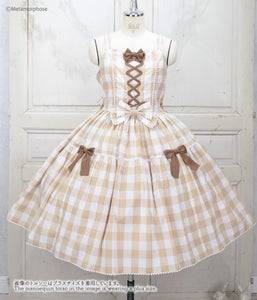


Left: Meta's Gingham Special Set JSK | Middle: MM's Deborah Doll (2012) | Right: VM's Classical Doll (2023)



Left: VM's Lace Ribbon Under JSK (2017) | Middle: IW's Maiden's Rose Garden Cross JSK | Right: AP's Day Dream Carnival (2024 MTO)



Left: VM's Noble Satin Marie JSK | Middle: VM's Rococo Bouquet Marie Rose JSK (2024) | IW's Violets Inside Mansion Triple Ribbon JSK (2017)



Left: Jewelry Classical Doll (2024) in Garnet Size 2 | Right: Infanta's Tangled JSK
Skirts
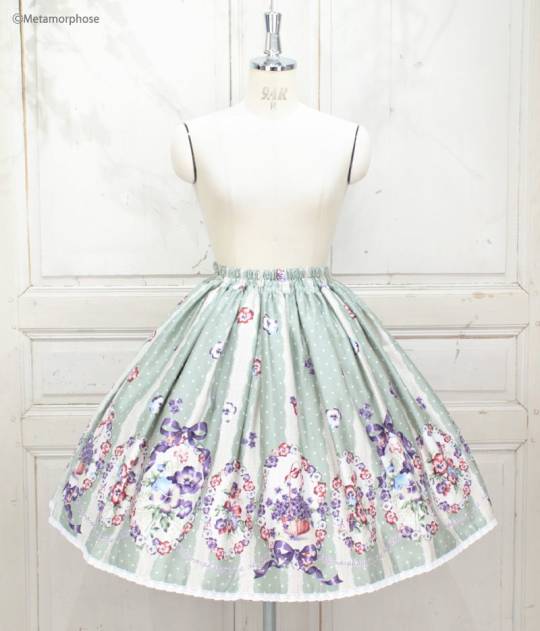

Left: Meta's Violets Bouquet Shirring Skirt | RIght: Haenuli's Winnie the Pooh JSK
Aprons



Left: The Black Ribbon's Classic Pinafore | Middle: AtePie's Enchanting Apron | Right: Lily of the Valley Designs' Herb Valley Apron
6 notes
·
View notes